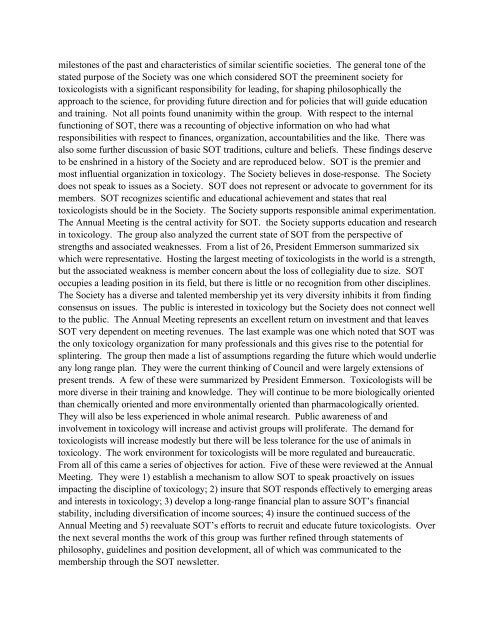SOCIETY O. TOXICOLOGY HISTORY - Society of Toxicology
SOCIETY O. TOXICOLOGY HISTORY - Society of Toxicology
SOCIETY O. TOXICOLOGY HISTORY - Society of Toxicology
Create successful ePaper yourself
Turn your PDF publications into a flip-book with our unique Google optimized e-Paper software.
milestones <strong>of</strong> the past and characteristics <strong>of</strong> similar scientific societies. The general tone <strong>of</strong> the<br />
stated purpose <strong>of</strong> the <strong>Society</strong> was one which considered SOT the preeminent society for<br />
toxicologists with a significant responsibility for leading, for shaping philosophically the<br />
approach to the science, for providing future direction and for policies that will guide education<br />
and training. Not all points found unanimity within the group. With respect to the internal<br />
functioning <strong>of</strong> SOT, there was a recounting <strong>of</strong> objective information on who had what<br />
responsibilities with respect to finances, organization, accountabilities and the like. There was<br />
also some further discussion <strong>of</strong> basic SOT traditions, culture and beliefs. These findings deserve<br />
to be enshrined in a history <strong>of</strong> the <strong>Society</strong> and are reproduced below. SOT is the premier and<br />
most influential organization in toxicology. The <strong>Society</strong> believes in dose-response. The <strong>Society</strong><br />
does not speak to issues as a <strong>Society</strong>. SOT does not represent or advocate to government for its<br />
members. SOT recognizes scientific and educational achievement and states that real<br />
toxicologists should be in the <strong>Society</strong>. The <strong>Society</strong> supports responsible animal experimentation.<br />
The Annual Meeting is the central activity for SOT. the <strong>Society</strong> supports education and research<br />
in toxicology. The group also analyzed the current state <strong>of</strong> SOT from the perspective <strong>of</strong><br />
strengths and associated weaknesses. From a list <strong>of</strong> 26, President Emmerson summarized six<br />
which were representative. Hosting the largest meeting <strong>of</strong> toxicologists in the world is a strength,<br />
but the associated weakness is member concern about the loss <strong>of</strong> collegiality due to size. SOT<br />
occupies a leading position in its field, but there is little or no recognition from other disciplines.<br />
The <strong>Society</strong> has a diverse and talented membership yet its very diversity inhibits it from finding<br />
consensus on issues. The public is interested in toxicology but the <strong>Society</strong> does not connect well<br />
to the public. The Annual Meeting represents an excellent return on investment and that leaves<br />
SOT very dependent on meeting revenues. The last example was one which noted that SOT was<br />
the only toxicology organization for many pr<strong>of</strong>essionals and this gives rise to the potential for<br />
splintering. The group then made a list <strong>of</strong> assumptions regarding the future which would underlie<br />
any long range plan. They were the current thinking <strong>of</strong> Council and were largely extensions <strong>of</strong><br />
present trends. A few <strong>of</strong> these were summarized by President Emmerson. Toxicologists will be<br />
more diverse in their training and knowledge. They will continue to be more biologically oriented<br />
than chemically oriented and more environmentally oriented than pharmacologically oriented.<br />
They will also be less experienced in whole animal research. Public awareness <strong>of</strong> and<br />
involvement in toxicology will increase and activist groups will proliferate. The demand for<br />
toxicologists will increase modestly but there will be less tolerance for the use <strong>of</strong> animals in<br />
toxicology. The work environment for toxicologists will be more regulated and bureaucratic.<br />
From all <strong>of</strong> this came a series <strong>of</strong> objectives for action. Five <strong>of</strong> these were reviewed at the Annual<br />
Meeting. They were 1) establish a mechanism to allow SOT to speak proactively on issues<br />
impacting the discipline <strong>of</strong> toxicology; 2) insure that SOT responds effectively to emerging areas<br />
and interests in toxicology; 3) develop a long-range financial plan to assure SOT’s financial<br />
stability, including diversification <strong>of</strong> income sources; 4) insure the continued success <strong>of</strong> the<br />
Annual Meeting and 5) reevaluate SOT’s efforts to recruit and educate future toxicologists. Over<br />
the next several months the work <strong>of</strong> this group was further refined through statements <strong>of</strong><br />
philosophy, guidelines and position development, all <strong>of</strong> which was communicated to the<br />
membership through the SOT newsletter.
















